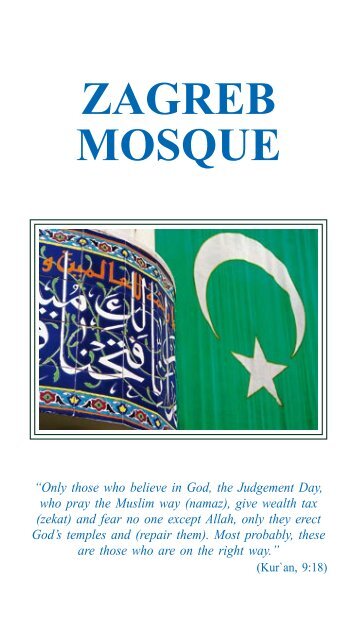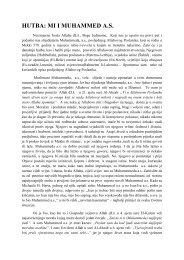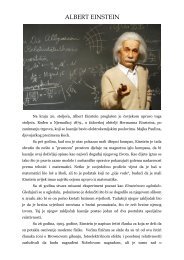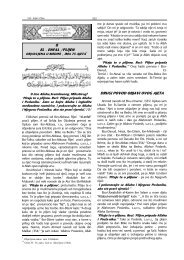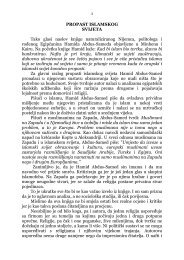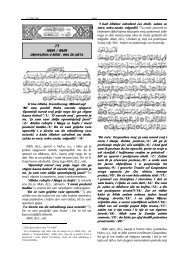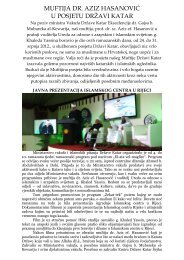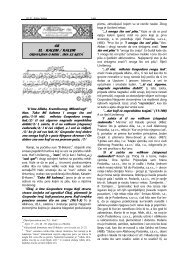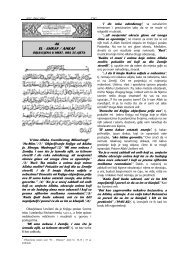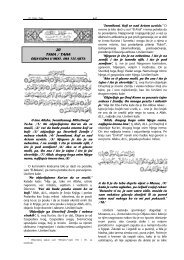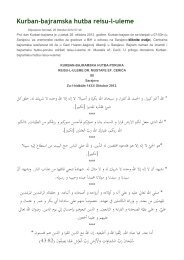ZAGREB MOSQUE - Islamska zajednica u Hrvatskoj
ZAGREB MOSQUE - Islamska zajednica u Hrvatskoj
ZAGREB MOSQUE - Islamska zajednica u Hrvatskoj
You also want an ePaper? Increase the reach of your titles
YUMPU automatically turns print PDFs into web optimized ePapers that Google loves.
<strong>ZAGREB</strong><br />
<strong>MOSQUE</strong><br />
“Only those who believe in God, the Judgement Day,<br />
who pray the Muslim way (namaz), give wealth tax<br />
(zekat) and fear no one except Allah, only they erect<br />
God’s temples and (repair them). Most probably, these<br />
are those who are on the right way.”<br />
(Kur`an, 9:18)
Series<br />
TOURISM AND HERITAGE<br />
No 73<br />
ISBN 978-953-215-579-2<br />
Editors<br />
Zlatko Hasanbegović, Ana Ivelja-Dalmatin,<br />
Senad Nanić, Mato Njavro,<br />
Maja Perišin, Mirsad Srebreniković,<br />
Iva Vranješ, Marija Vranješ, Khaled Yassin<br />
Editor-in-Chief<br />
Mato Njavro<br />
Responsible Editor<br />
Ana Ivelja-Dalmatin<br />
Photos<br />
Zoran Filipović, Zlatko Hasanbegović, Avdo Imširović,<br />
Patrik Macek, Arhiv Islamskog centra<br />
Publisher<br />
Turistička naklada d.o.o., Zagreb<br />
For Publisher<br />
Marija Vranješ<br />
© Copyright by Turistička naklada<br />
Photolitographs<br />
O_TISAK, Zagreb<br />
Print<br />
PRINTERA, Zagreb<br />
<strong>ZAGREB</strong><br />
<strong>MOSQUE</strong><br />
Koran, sura (chapter) El-Kevser<br />
Text<br />
ZLATKO HASANBEGOVIĆ<br />
SENAD NANIĆ<br />
Translation from English<br />
Živan Filippi, Ph.D.<br />
English Language Revision<br />
Jeremy Irving, B.A.<br />
Zagreb, 2009
The elegant minaret of the Zagreb Mosque<br />
<br />
Sura 1.<br />
THE OPENING SURA – AL-FĀTIH. A<br />
(Proclaimed in Mecca; ajet (line) 7; proclaimed after<br />
the sura One that covers himself – al-Mudettir)<br />
In the name of Allah All-merciful and Pitying<br />
1. Thanks belong to Allah, Who is the Master of worlds,<br />
The City of Zagreb is the<br />
administrative and political<br />
centre of the Republic of Croatia.<br />
Due to its geographical<br />
and geopolitical position, it is<br />
at the crossroads of the routes<br />
between central and southeastern<br />
Europe and the Adriatic<br />
Sea and both its location<br />
and historical development<br />
2. To All-merciful and Pitying,<br />
3. To the Ruler on the Day of Faith;<br />
4. We adore You and ask help from You –<br />
5. Direct us to the right way,<br />
6. To the Way of those whom you lavished with Your blessings,<br />
7. And not of those you are angry with,<br />
Or those who have gone astray!<br />
Koran, sura El-Fatiha<br />
MUSLIMS IN <strong>ZAGREB</strong><br />
A BRIEF HISTORY<br />
have made the city a waypoint<br />
between Catholic central Europe<br />
and Islamic south-eastern<br />
Europe, where Muslim traditions,<br />
culture and heritage are<br />
deeply rooted. This is obvious<br />
to anyone approaching Zagreb<br />
from the East, who will notice<br />
the white minaret of the<br />
Zagreb Mosque on the left.
The grand building of the Zagreb Mosque
Zagreb Mosque was built by great efforts and persistence of the Zagreb<br />
Muslim community<br />
It is one of the landmarks of<br />
the modern quarter of the city,<br />
but also a sign of religious and<br />
cultural identity, and a symbol<br />
of the permanent presence of<br />
the oldest Muslim community<br />
in central Europe. According<br />
to the 2001 census, among<br />
4,437.460 inhabitants of the<br />
Republic of Croatia, there are<br />
56, 777 Muslims of various<br />
ethnic origin (Bosnian, Croat,<br />
Albanians, Romany and others),<br />
comprising 1.28% of<br />
population. After the Roman<br />
Catholics and Orthodox Christians,<br />
Muslims account for the<br />
third largest religious community.<br />
Almost a third of them<br />
live in Zagreb and are at the<br />
centre of Muslim religious,<br />
social, cultural and educational<br />
life in the Republic of Croatia.<br />
According to the same census,<br />
Zagreb has 779, 145 inhabitants,<br />
among whom are 16, 215<br />
Muslims, living throughout the<br />
city. Muslims comprise 2.08%<br />
of the city’s population, and<br />
are the second religious group<br />
after the Roman Catholics.<br />
Although this is a relatively<br />
small Islamic community, Islam<br />
is a traditional and native faith<br />
in the Republic of Croatia and<br />
in the City of Zagreb, practised<br />
The first Zagreb biography of the<br />
God’s envoy Mohamed a.s. from<br />
the 18 th century<br />
for centuries and enjoying a legal<br />
basis. City communal and<br />
fiscal sources record Muslims<br />
in Zagreb in the middle of the<br />
18 th century, when groups of<br />
Muslim merchants from Bosnia<br />
stayed in Zagreb doing<br />
business; they were attracted<br />
by trade privileges and the<br />
revival in trade after the very<br />
long wars between Christian<br />
Austria and the Muslim Ottoman<br />
Empire. The vicinity<br />
of Ottoman Bosnia incited a<br />
greater interest in Islam within<br />
the city’s intellectual and cultural<br />
circles. Thus, the Austrian
Oriental philologist and diplomat<br />
Franz Dombay published<br />
in Zagreb the biography of<br />
God’s emissary Mohammed,<br />
as the pioneering work of European<br />
Oriental Studies. He<br />
described Islamic teaching in<br />
an objective way without the<br />
usual polemical discourse. The<br />
turning-point occurred in 1878<br />
following the Austro-Hungarian<br />
annexation of the westernmost<br />
Ottoman province of<br />
Bosnia and Herzegovina. From<br />
that point, Bosnia and Herzegovina<br />
was within the framework<br />
of the various regions<br />
comprising today’s Republic of<br />
Croatia. The inclusion of Bosnia<br />
and Herzegovina within the<br />
Habsburg Monarchy at the end<br />
of the 19 th century represented<br />
a break with the centuries-old<br />
state, legal and cultural barriers<br />
between Christians and Muslims<br />
in these regions. It was<br />
the beginning of the gradual<br />
formation of a specific Muslim<br />
community in Zagreb, together<br />
with its religious and attendant<br />
social institutions. The first<br />
Muslims in Zagreb after 1878<br />
were young men from Bosnia<br />
and Herzegovina of various<br />
professions who came looking<br />
for job; a special group was<br />
10 10 11 comprised of Muslim pupils<br />
and students at Zagreb University,<br />
who left a significant<br />
mark in Croatian public and<br />
cultural life at the end of the<br />
19 th century. These beginnings<br />
of a Muslim community<br />
are witnessed by the fact that<br />
the first Muslim was buried in<br />
the Zagreb Mirogoj cemetery<br />
in 1883; his tomb marked the<br />
start of the oldest Muslim cemetery<br />
in central Europe. A special<br />
feature of the cemetery is a<br />
two-metre high Islamic monument<br />
from 1873, outstanding<br />
in its beauty and detail.<br />
The census of 1910 recorded<br />
the existence of a small<br />
35-strong Muslim community<br />
in Zagreb which grew to 2000<br />
permanent inhabitants in 1941.<br />
The rise of the Muslim community<br />
in Zagreb created a<br />
need for a legal framework as<br />
a prerequisite for the formation<br />
of a permanent Islamic community,<br />
together with its religious,<br />
cultural and educational<br />
institutions. Therefore in 1916,<br />
the Croatian Sabor (Parliament)<br />
passed “The Act of Recognition<br />
of Islamic confession in<br />
the Kingdoms of Croatia and<br />
Slavonia”, which guaranteed<br />
Islam the same legal protec-<br />
Nišan (stonetomb) of the Ferhatović family in the Mirogoj cemetery<br />
from 1893
12 12 13 tion accorded to other faiths,<br />
and also the possibility of establishing<br />
religious communities<br />
with a close connection<br />
with those in Bosnia and Herzegovina.<br />
This Croatian law of<br />
1916 represents, together with<br />
the Austrian act of 1912, the<br />
oldest recorded recognition<br />
of Islam in Europe outside<br />
an area controlled for centuries<br />
by the Ottoman Empire.<br />
At the beginning of the First<br />
World War, a great many Muslim<br />
soldiers from Bosnia and<br />
Herzegovina were conscripted<br />
in various Austro-Hungarian<br />
military units. Pre-dating legal<br />
recognition of Islam, The Impe-<br />
rial and Royal Islam Military<br />
Spiritual Tutorship in Zagreb<br />
was founded in 1915 for the<br />
spiritual needs of Muslim soldiers<br />
and citizens. This was the<br />
first local Islamic institution at<br />
the head of which presided a<br />
military imam among whose<br />
duties was to register the death<br />
of Muslim soldiers and citizens<br />
until the end of the First<br />
World War, and who taught the<br />
Islamic faith to Muslim youth<br />
in Zagreb schools.<br />
After the establishment of<br />
the new state of the Serbs, Croats<br />
and Slovenes, which was<br />
later called Yugoslavia, a new<br />
wave of Muslim immigrants<br />
A century of the legal recognition of Islam in Croatia The first mesdžid (small mosque) in Zagreb was opened in 1935
1 1 1<br />
same year, as the first Muslim<br />
centre of prayer. Today, it<br />
is the seat of the Mešihat of<br />
the Islamic community in the<br />
Republic of Croatia. The deep<br />
roots of the Muslim community<br />
in Zagreb society were<br />
confirmed in 1940 by the appointment<br />
of the first Muslim<br />
to the city council.<br />
The full administration of<br />
Islamic religious life, as it existed<br />
in Bosnia and Herzegovina,<br />
was implemented at the end<br />
of 1935 when the state sharia<br />
Muslim students from Bosnia<br />
and Herzegovina, who were<br />
also setting up academic clubs<br />
at Zagreb University. Thus,<br />
the sub-committee of Gajret,<br />
a Muslim cultural and educational<br />
society, was founded in<br />
1921 as the first Muslim society<br />
in Zagreb. Later, the Zagreb<br />
local board of the Muslim cultural<br />
society Narodna uzdanica<br />
was established, which later<br />
evolved into an academic society.<br />
This was the central Muslim<br />
cultural and educational in-<br />
The Zagreb Muslim Youth in mekteb (elementary school) in 1930’s court, responsible<br />
for Muslim weddings,<br />
family and<br />
The first Zagreb mufti (1919 -1945) Ismet<br />
ef. Muftić, the founder of the religious end<br />
educational life<br />
from Bosnia and Herzegovina was established, which received<br />
inheritance matters,<br />
arrived in Zagreb to work in not only muftis but also the<br />
was established. It<br />
the important industrial and representatives of the Zagreb<br />
ruled according to<br />
commercial trade centre of Muslim community. The fact<br />
sharia marital and<br />
the new state. This continued that Zagreb radio broadcast<br />
family law, whose<br />
the formation of the Muslim ezan (the Islamic invitation to<br />
application was<br />
community and its religious, prayer) for the first time, and<br />
guaranteed by the<br />
cultural and social institutions then transmitted live important<br />
constitution and<br />
within the Zagreb society. Is- Islamic religious services until<br />
by law. In parallel<br />
lamic religious life began in the 1945, illustrates the growth<br />
with other religious<br />
city in 1919 outside the frame- of the number of Muslims in<br />
institutions, Muswork<br />
of the military spiritual the city. In 1936, the Zagreb<br />
lim societies were<br />
tutorship, when an imam was city authorities provided offi-<br />
established dealing<br />
appointed, who was given the cial premises for the Muslim<br />
with a broad range<br />
title of mufti in 1922. Along community. They were situ-<br />
of cultural, educa-<br />
with the offices of imam and ated in the city centre, at 12<br />
tional and social<br />
mufti, the Islamic religious Tomašićeva Street, where the<br />
matters. They were<br />
commune (Džematski medžlis) mesdžid was opened in the<br />
mostly attended by
1 1 1<br />
The first Zagreb mosque (1944 – 1948), Meštrović’s Pavilion, reconstructed<br />
according to the design of the architects Stjepan Planić and Zvonimir Požgaj
stitution in Zagreb until 1945.<br />
Muslims also gathered around<br />
Društvo zagrebačkih muslimana<br />
(the Society of Zagreb<br />
Muslims), which was active<br />
from 1939 until 1945 and was<br />
also known as the Hrvatsko<br />
muslimansko društvo.<br />
As part of the strengthening<br />
of the Muslim community in the<br />
middle of the 1930’s, there was<br />
an initiative to build a mosque<br />
in Zagreb. This would symbolically<br />
incorporate Islam in traditional<br />
city confessions. The<br />
notion of building a mosque in<br />
Zagreb had surfaced as early<br />
as 1908, as part of the political<br />
and administrative actions<br />
of the Party of Rights during<br />
the annexation of Bosnia and<br />
Herzegovina. This party wanted<br />
to emphasize its pro-Muslim<br />
stance and win over Muslims<br />
for its own aims and was in<br />
tune with the thoughts of the<br />
founder of the modern Croatian<br />
nation, Ante Starčević. The invitation<br />
to tender for the building<br />
of the mosque appeared in<br />
Zagreb newspapers in October<br />
1908. It would meet the needs<br />
of Muslims who regularly<br />
came to the city. Družba braće<br />
hrvatskoga zmaja (The Society<br />
of the Brothers of the Croatian<br />
1 1 1<br />
Dragon) joined the initiative in<br />
1912 and raised donations from<br />
its members to help pay for the<br />
building. However, after some<br />
unsuccessful attempts during<br />
the Yugoslav period after 1918,<br />
the local board of the Muslim<br />
cultural society Narodna uzdanica<br />
concluded in 1936 that<br />
it would establish “a foundation<br />
for the building of a mosque<br />
and other religious and educational<br />
institutions”, together<br />
with Džematski medžlis, the<br />
community of Zagreb, Matica<br />
hrvatska and Hrvatski radiša.<br />
The Zagreb Džematski medžlis<br />
determined the foundation charter<br />
and the statute of the Zaklada<br />
za izgradnju džamije i<br />
zgrada za održavanje džamije<br />
te smještaj islamskih vjerskoprosvjetnih<br />
ustanova u Zagrebu<br />
(The Foundation for building<br />
the mosque and buildings for<br />
the maintenance of the mosque,<br />
and the accommodation of Islamic<br />
religious and educational<br />
institutions in Zagreb). These<br />
documents laid down how<br />
funds would be gathered and<br />
spent for the building of the<br />
mosque and how the foundation<br />
bodies would be organized.<br />
The Zagreb city authorities decided<br />
in October 1940 to build<br />
The interior of the first Zagreb mosque
the mosque at Zelengaj, in the<br />
north of the city, whilst the architect<br />
Zvonimir Požgaj and the<br />
painter Omer Mujadžić were<br />
entrusted with the submission<br />
of the designs. In August 1941,<br />
the city authorities amended the<br />
overall design of the mosque to<br />
include the Artists Home, previously<br />
in the centre of the city,<br />
built to a design of the sculptor<br />
Ivan Meštrović. The mosque<br />
was opened in the summer of<br />
1941. The exterior arrangement<br />
was conceived by one of<br />
the leading Croatian architects<br />
Stjepan Planić, and the interior<br />
20 20 21 of the mosque was designed by<br />
the architect Zvonimir Požgaj.<br />
The three concrete-reinforced<br />
minarets 46 metres high and<br />
the outside fountain (šadrvan)<br />
were completed in the spring of<br />
1943. A new dome was erected<br />
in the interior of the mosque<br />
which brought light into the hall<br />
and carried a one-ton hanging<br />
lamp. The partition walls were<br />
removed, the imam’s office and<br />
two flats, the classroom for religious<br />
studies and two mahfils<br />
(an area restricted to women)<br />
were added, one in the form<br />
of a gallery on the first floor<br />
Part of the fence of the minber (pulpit) in the first Zagreb mosque<br />
Remains of the first Zagreb mosque (ćurs /pulpit, mihrab, minber), the<br />
exhibity in the Islamic Centre<br />
Replica of the interior decoration<br />
in the first Zagreb mosque<br />
and another on the semi-circular<br />
balcony above the entrance<br />
to the hall. The monumental<br />
mihrab, and mimber and ćurs<br />
(pulpits) were situated in the<br />
prayer hall. The walls of the<br />
mosque were lined with green<br />
Italian marble and adorned with<br />
travertine decoration of early<br />
Croatian interlaced-ribbon motifs<br />
and Arabic calligraphy. The<br />
floors were covered with forty<br />
Persian rugs of the Isfahan<br />
type. The opening of The Zagreb<br />
Mosque, which ranked,<br />
through its sheer size and scale,
A motif from the opening of the new Zagreb mosque<br />
22 22 23 Koran the Honourable, the proclaimed God’s word and direction sign<br />
in the life of Muslims<br />
among the world’s outstanding<br />
mosques, represented a symbolic<br />
coronation of the protracted<br />
development of the Muslim<br />
community in Zagreb,<br />
The establishment of communism<br />
after the Second World<br />
War and the deep political and<br />
social changes which ensued<br />
strongly influenced the Zagreb<br />
Muslim community. Following<br />
the social and religious achievements<br />
of the first generation<br />
of Zagreb Muslims, they now<br />
found themselves under various<br />
forms of repression. Muslim<br />
societies and institutions, with<br />
the exception of religious representation,<br />
were dissolved and<br />
banned, whilst the trial and execution<br />
of the Zagreb mufti in<br />
1945, together with the destruction<br />
of minarets and the closure<br />
of the first Zagreb Mosque in<br />
1948, marked the end of the<br />
foundation period of the Muslim<br />
presence in Zagreb. The<br />
Muslim community reverted to<br />
its modest framework of 1918,<br />
and was forced to try to develop<br />
and restore its institutions in<br />
the difficult and unfavourable<br />
circumstances of the post-war<br />
period. The preserved remains<br />
of the first Zagreb Mosque,<br />
among which is the magnificent<br />
mihrab, are exhibited today in<br />
the new mosque’s museum.
Šadrvan (fountain) in the first Zagreb mosque<br />
2 2 2<br />
CONTEMpORARY SITUATION<br />
After the Second World War,<br />
intensive Muslim immigration<br />
to Zagreb from the country’s<br />
regions continued. They<br />
were drawn from various professions,<br />
social strata and ethnic<br />
origins, and among them<br />
were Muslim Albanians from<br />
Kosovo and Macedonia, who<br />
today constitute the main element<br />
of the Muslim community.<br />
An increase in the Muslim<br />
community occurred at<br />
the end of the 1960’s and the<br />
beginning of the 1970’s, when<br />
A view to the façade<br />
The Mosque while building
discussions began about building<br />
a new mosque in Zagreb,<br />
which would become the centre<br />
of Islamic religious and<br />
social life; it would also be a<br />
symbol of the important role<br />
of a great number of Muslims<br />
in Croatian and Zagreb public<br />
and cultural life. Although<br />
the authorities tried through<br />
various administrative means<br />
to make the realization of the<br />
project difficult, the foundation-stone<br />
of the new Zagreb<br />
Mosque was laid in 1981, in<br />
what was then a suburb of<br />
Zagreb, but what is now an<br />
area linked to the city centre<br />
by good roads.<br />
The building of the mosque<br />
was dogged by difficulties<br />
but supported by great dedication<br />
and the persistence of<br />
the community at large and<br />
in particular by its building<br />
committee. It was completed<br />
in 1987 when the mosque was<br />
open to the public as a symbol<br />
of an ancient and reborn community.<br />
The mosque transcended<br />
the local Muslim community<br />
and became one of the most<br />
important Islamic centres in<br />
2 2 2<br />
Europe, due to its programme<br />
of religious, social, cultural<br />
and educational activities. It<br />
connected the more recent<br />
Muslim communities in western<br />
Europe with the original<br />
and traditional Islam in southeastern<br />
Europe.<br />
The restoration and<br />
strengthening of the Zagreb<br />
Muslim community after the<br />
opening of the mosque was<br />
confirmed by the final formation<br />
of independent Islamic<br />
religious institutions in the<br />
Republic of Croatia, with their<br />
seat in Zagreb. The Islamic<br />
community in the Republic<br />
of Croatia is active today as<br />
a recognized and independent<br />
religious community, which<br />
agreed its position and significance<br />
by a contract with the<br />
state on mutual relationships.<br />
The institutions of the Islamic<br />
community in the Republic of<br />
Croatia, which is connected<br />
through reis-ul-ulema in Sarajevo<br />
with the Islamic community<br />
in Bosnia and Herzegovina,<br />
are the Sabor of the<br />
Islamic community, as a national<br />
religious representative<br />
body, the Mešihat with the<br />
Zagreb Ramadan candles
The builders of the Zagreb Mosque<br />
2 2 2
Mosque, a place of inter-religious dialogue<br />
Zagreb mufti as the executive<br />
body of the Sabor, and<br />
the network of Mežlises (Islamic<br />
religious communities)<br />
which are active throughout<br />
the country. The Zagreb<br />
Mosque and the Islamic<br />
Centre took on a significant,<br />
broader social role during and<br />
after the armed aggression<br />
against both the Republic of<br />
Croatia and Bosnia and Herzegovina<br />
from 1991 to 1995<br />
by becoming a refuge for<br />
thousands of people fleeing<br />
30 30 31 the fighting, and also a centre<br />
of charitable work. The Zagreb<br />
Mosque was a gathering<br />
place for Muslims who took<br />
part in defending the homeland<br />
and in the establishment<br />
of the independent Republic<br />
of Croatia. 39 Zagreb Muslims<br />
gave their lives for Croatia<br />
as part of Croatian Army<br />
units. The monument in the<br />
Islamic Centre is a permanent<br />
reminder of their sacrifice as<br />
well as that of all Muslim<br />
defenders of the Republic of<br />
Croatia from other parts of<br />
the country and also from<br />
Bosnia and Herzegovina.<br />
The Zagreb Mosque and<br />
Islamic Centre is run by the<br />
Executive Committee of the<br />
Medžlis of the Islamic community<br />
of Zagreb, whose members<br />
are chosen by the džemat<br />
- the local Muslim community.<br />
The main task of the Zagreb<br />
Executive Committee of the<br />
Medžlis is to strengthen the<br />
social cohesion of the community,<br />
besides maintaining the<br />
buildings and ensuring that<br />
Visit of the Iranian President Mohammad Khatami<br />
regular religious services and<br />
educational classes can take<br />
place. The Executive Committee<br />
of the Medžlis works<br />
through specialized councils<br />
dealing with particular social<br />
areas, e.g. youth; it also<br />
oversees the work of the Merhamet<br />
charity. 14 imams and<br />
many teachers of Islam undertake<br />
religious instruction,<br />
which takes place regularly<br />
both in the mosque and in the<br />
city’s schools. Wedding ceremonies<br />
are performed in the<br />
mosque and as per the agree-
ment between the state and<br />
the Islamic community, the<br />
Islamic service is recognized<br />
as having full civil and legal<br />
rights. Today, the ‘Dr. Ahmed<br />
Smajlović’ Islamic Grammar<br />
School which is also secondary<br />
modern school, is part of<br />
the mosque and the Islamic<br />
Centre and is integrated into<br />
the Croatian educational system.<br />
It was founded in 1993<br />
as a madrassah - an Islamic<br />
religious school. ‘Arabeske’,<br />
the female choir of the Za-<br />
The Zagreb mufti Ševko ef. Omerbašić<br />
32 32 33 greb Mosque, is well-known<br />
outside Zagreb for its varied<br />
performances and concerts.<br />
The city kindergarten ‘Jasmin’<br />
was opened in the Islamic<br />
Centre for all children,<br />
regardless of their faith, together<br />
with the sports centre<br />
and playground of the football<br />
club Nur. Since opening, both<br />
the Zagreb Mosque and the Islamic<br />
Centre have become a<br />
focus for authentic European<br />
Islamic thinking, confirmed<br />
by its wide literary output, nu-<br />
The Prime Minister of Malaysia Mahathir bin Mohamad visiting the<br />
Islamic Centre<br />
The President of the Republic of Croatia Stjepan Mesić visiting the<br />
Zagreb medrese “Dr. Ahmed Smajlović”
School leavers of the Zagreb medrese “Dr. Ahmed Smajlović”<br />
Sharia wedding in Zagreb<br />
3 3 3<br />
The Mosque – the meeting place of ulema (theologians) from the whole<br />
Islamic world
merous international scientific<br />
symposia.<br />
There is a regular Islamic<br />
meeting on Thursday at the<br />
‘Dr. Sulejman Mašović’ centre,<br />
named after its founder<br />
who was an outstanding Zagreb<br />
Muslim and it is today<br />
one of the oldest institutions<br />
3 3 3<br />
The female choir “Arabeske” have attracted the hearts of the public in<br />
all its performances since 1993<br />
in the city. The Zagreb Islamic<br />
Centre is also well-known in<br />
Europe as a Koran learning<br />
centre, much appreciated in<br />
world Islamic circles, and as a<br />
venue for dialogue with other<br />
faiths.<br />
With its extensive facilities,<br />
the Zagreb Mosque embod-<br />
ies the most significant symbols<br />
of universal meaning of<br />
Islam as a faith for all men<br />
and women, races, locations<br />
and civilizations; and is a permanent<br />
monument to Islamic<br />
values as an inseparable part<br />
of European culture and civilization.<br />
Winners of the table-tennis<br />
tournament in the sports hall of<br />
the Islamic Centre
The “Jasmin” kindergarten<br />
Mekteb (elementary school) in the Islamic Centre<br />
3 3 3<br />
The mayor of Zagreb, a friend of the football club “Nur”<br />
Sports Centre “Nur”
Waiting for the prayer<br />
0 0 1 The Mevlud Feast (the holy day of the birth of Mohamed)<br />
The final celebration of the European competition of learners of the Koran
2 2 3 BUILdING CHARACTERISTICS OF THE<br />
<strong>MOSQUE</strong> ANd ISLAMIC CENTRE<br />
W hen the Zagreb Mosque<br />
is mentioned, one refers<br />
to a large building, the greatest<br />
in this part of Europe. One is<br />
aware of the building’s difficult<br />
inception, the involvement of<br />
prominent individuals and donors,<br />
and one is conscious of<br />
the role of the mosque in the<br />
life of the Zagreb Muslim community.<br />
Sometimes, attention<br />
is drawn to the designers and<br />
builders, but the architectonic<br />
and building characteristics of<br />
the very project are often neglected.<br />
Everybody agrees that<br />
this is a very successful and<br />
aesthetically exceptional enterprise.<br />
The mosque was opened<br />
in 1987 built by the Zagreb<br />
builders “Tehnika”. The man<br />
behind the preliminary design<br />
is Džemal Čelić, an architect<br />
and Professor at Sarajevo<br />
University and a great connoisseur<br />
of the Islamic building<br />
tradition of Bosnia and<br />
Herzegovina. His design was<br />
co-authored by Mirza Gološ,<br />
also an architect from Sarajevo,<br />
whilst the calligraphy is<br />
by Ešref Kovačević, the best<br />
known Bosnian calligrapher of<br />
the time.<br />
Main façade The monumental sliding door of copper, the work of the academic<br />
sculptor Šefkija Baručija
Sedžda (prostration)
An orchard in front of the Mosque<br />
<br />
Džuma (Muslim prayer on Friday)<br />
The first mosque was erected<br />
by God’s emissary Mohamed<br />
a.s. in the village of Kuba<br />
not far from Medina during the<br />
time of the hidžra from Mecca<br />
to Medina. The first mosques<br />
did not yet have all those elements<br />
which constitute recognizable<br />
characteristics of each<br />
Islamic shrine. Thus, with the<br />
first mosques, kibla (the direction<br />
of the prayer towards Mecca)<br />
was marked by one stone<br />
in the wall, whilst the classic<br />
mihrab (the niche in the wall<br />
directed towards Mecca), the<br />
minber (pulpit) and the minaret<br />
became in time the constitutive<br />
elements of every mosque.<br />
ON <strong>MOSQUE</strong>S...<br />
The name ‘mosque’ is derived<br />
from the Arabic root<br />
meaning gathering and being<br />
together; it was used in both<br />
the Ottoman and in the previous<br />
Seljuk tradition for larger<br />
places of worship where common<br />
prayer would be held<br />
on Fridays. The name of the<br />
Tespih (Muslim rosary)
prayer, as well as that of the<br />
day Friday itself – džum, is<br />
derived from the same Arabic<br />
root. The name for the<br />
basic community of Muslims<br />
– džemat also derives from<br />
this root. Another name for<br />
a mosque – mesdžid is older<br />
and is mentioned in the Koran.<br />
Mesdžid means the place of<br />
A view to the interior of the Zagreb Mosque<br />
<br />
sedžda, or the religious expression<br />
of humility before God by<br />
touching the floor with one’s<br />
forehead; this is one element in<br />
each of five daily personal and<br />
obligatory prayers. The word<br />
mosque has not become part of<br />
Arab tradition, but all mosques<br />
and mesdžids are commonly<br />
called mesdžids. From this<br />
came the Spanish<br />
word mezguita,<br />
English mosque and<br />
German Moschee.<br />
It also influenced<br />
the Croatian form<br />
of mošeja, which,<br />
however, was not<br />
adopted due to the<br />
popular traditional<br />
words džamija and<br />
mesdžid. In the Ottoman<br />
tradition in<br />
central and southeastern<br />
Europe, each<br />
place of worship<br />
which has a munara,<br />
or the tower<br />
from which a mullah<br />
calls the faithful<br />
to prayer is džamija<br />
(mosque), and all<br />
other places of worship<br />
are mesdžids.<br />
There are differences<br />
in the interiors of<br />
Hutba (preaching) on Friday<br />
mosques and mesdžids. Both<br />
of them have a mihrab, a niche<br />
in the front wall marking the<br />
obligatory direction for each<br />
common and personal prayer,<br />
which points to Mecca or a<br />
building called Bejtullah, the<br />
first of God’s houses erected<br />
by Ibrahim/Abraham, God’s<br />
emissary. Mosques also have<br />
a minber, a pulpit situated to<br />
the right of the mihrab, from<br />
which the imam addresses the<br />
faithful on Friday and on holy<br />
days, as was done by God’s<br />
emissary Mohammed. To the<br />
left of mihrab, there is ćurs,<br />
from the Arabian name for<br />
chair, from where lectures are<br />
delivered separate from the religious<br />
service. Mosques and<br />
mesdžids can have domes or<br />
roofs, they can have harems<br />
(fenced courtyards), mahfils<br />
(prayer galleries), šadrvans<br />
(fountains) and abdesthans<br />
(basins for ceremonial cleansing<br />
before prayer). There is a<br />
lot of varied mosque typology<br />
throughout history, and in the<br />
many cultures and civilizations<br />
of the Islamic world.
0 0 1 The ceramic calligraphic frieze with the text of the Koran sura “Jasin”<br />
“There is no divinity except God, and Mohamed is God’s envoy”<br />
Besides the basic exterior<br />
and interior architectonic<br />
elements, mosque decor is<br />
the most important feature in<br />
a mosque and renders each<br />
mosque recognizable within<br />
general Islamic architecture.<br />
Images are not forbidden as<br />
can be seen from the rich<br />
tradition of Islamic miniature<br />
painting, which were often<br />
used to illustrate manuscripts<br />
and other artefacts. The prohibition<br />
refers to the use of<br />
ON <strong>MOSQUE</strong> dECOR...<br />
figures for religious purposes.<br />
This is because the Richness of<br />
God’s person is characterized<br />
by the infinite transcendence of<br />
His figure. If it is presented in<br />
only two or three dimensions,<br />
this figure is then completely<br />
unworthy of the Grace directed<br />
towards the heart of man. The<br />
Koran does not speak about<br />
man as an image of God, but<br />
of man’s nature which was<br />
made by God according to his<br />
Nature. The mind is therefore
A detail of the ornamental frieze in the Mosque<br />
directed towards the reality of<br />
the multiplicity of dimension<br />
in abstract thought only, both<br />
in science and in art. The confirmation<br />
of God’s oneness, tehvid,<br />
or the quest for the unity of<br />
God’s principles, does not lead<br />
to a false simplicity of God’s<br />
being. On the contrary, the principle<br />
of tehvid, supported by the<br />
Koran giving God many names,<br />
shaped and described in Deeds,<br />
leads the mind towards fresh<br />
and ever richer forms providing<br />
a harmonious answer to a given<br />
problem, but also permeating<br />
2 2 3 the entirety as well. Therefore<br />
it is natural that Islamic building<br />
heritage is characterized by<br />
a uniformity of construction<br />
and decor, where the three-dimensional<br />
is a natural indeterminate,<br />
continuous and integral<br />
part of the construction, following<br />
the noblest and most<br />
diverse geometrical patterns,<br />
and simultaneously complements<br />
the universal recognition<br />
and essence of Islamic building<br />
art. Islamic decor assumes not<br />
only a pure geometrical pattern,<br />
but also calligraphy and tevrik,<br />
for which the usual expression<br />
in European languages is arabesque.<br />
These are forms based<br />
THE FACILITIES OF THE <strong>ZAGREB</strong><br />
<strong>MOSQUE</strong><br />
Muslims living away from<br />
traditional centres do<br />
not live in a compact neighbourhood,<br />
but are scattered<br />
throughout the town. Therefore<br />
traditional forms of mesdžids<br />
and mosques cannot satisfy all<br />
on geometric rules which continue<br />
harmoniously in an abstract<br />
pattern.<br />
their religious needs. In new<br />
mosques, religious service is<br />
combined with cultural, educational<br />
and social activities.<br />
Such buildings are called Islamic<br />
centres which are similar<br />
to historical models of the
taurant with the divanhan (an<br />
area for meetings and dialogue)<br />
and classrooms for religious<br />
instruction. There are<br />
also flats for imams and guest<br />
rooms on the first floor. The<br />
madrassah is in the basement,<br />
which also has a kindergarten<br />
and a youth club with a small<br />
amphitheatre. In accordance<br />
with the design of the architect,<br />
Džemal Čelić, the building<br />
is divided according to its<br />
function. The southern section<br />
forms the area of the mosque<br />
and the northern section the<br />
The library of the Islamic Centre<br />
The restaurant in the Islamic<br />
Centre, a place of the traditional<br />
culinary art Congress Hall “Hadži Salim Šabić”<br />
largest mosque complexes in<br />
big traditional Islamic centres,<br />
capable of hosting other<br />
cultural and educational activities.<br />
As an Islamic Centre,<br />
the Zagreb Mosque fulfils<br />
mesdžid and a praying area<br />
and other functions too. The<br />
whole complex encompasses<br />
around 10,000 square metres,<br />
and consists of three sections:<br />
prayer, social and residential<br />
(an apartment for the<br />
imams and accommodation<br />
for guests). On the groundfloor,<br />
there is a congress hall,<br />
a reading room, offices, a res-<br />
Traditional cuisine
They are defined by an equilateral<br />
triangle, where every side<br />
is equal to the diameter of the<br />
parabola’s axial rotation. The<br />
rotational axes are not vertical<br />
but have a deviation which<br />
forms the symmetry of a threesided<br />
pyramid. This grouping is<br />
similar to a cluster of three soap<br />
bubbles affected by a force opposing<br />
their gravitation. Additionally,<br />
the construction of the<br />
dome is emphasized by vertical<br />
apertures enabling strong<br />
penetration of natural light to<br />
the very top of the dome. The<br />
dome is supported by three<br />
vertical parabolic consoles,<br />
transforming the dome into a<br />
strong visual identity for the<br />
entire community. At the same<br />
time, this enables the spread<br />
of natural light into gently<br />
curved white planes inside the<br />
dome and obviates the need for<br />
windows and selective natural<br />
lightning. The minaret has an<br />
original design: the traditional<br />
elegant cylinder of Ottoman<br />
Interesting construction of the Zagreb Mosque – a connection of the<br />
traditional and modern<br />
accompanying facilities. They<br />
are connected by a shallow<br />
tract emphasized by the small<br />
dome of the reading room and<br />
a spacious access terrace. The<br />
area of the mosque has been<br />
turned by approximately 45º<br />
in the direction of Mecca.<br />
The size of the Mosque is<br />
emphasized by its construction.<br />
The most important element is<br />
the dome, where the traditional<br />
Ottoman monumental circular<br />
dome has been constructed<br />
in a reinforced-concrete parabola.<br />
There are three cuts of<br />
rotational parabolas, elements<br />
created by their axial rotation.<br />
minarets is gently slanted into<br />
the form of an elongated cone<br />
42 metres high, rendering the<br />
dome even more dynamic. The<br />
external entrance to the mosque<br />
is accented with a small parabolic<br />
dome projecting from the<br />
main façade and lined with<br />
white marble. Three huge glid-
Dome – a strong visual identity of džemat (community of the faithful)<br />
The contact of modern architecture and the traditional Islamic building<br />
heritage<br />
ing bronze doors, designed by<br />
the academic sculptor Šefkija<br />
Baručija, are inserted into the<br />
dome. The northern section of<br />
facilities was not given prominence<br />
and is subordinate to the<br />
majesty of the mosque. The<br />
main façade is adorned with<br />
engraved calligraphy Bismillah,<br />
which is found at the beginning<br />
of each chapter of the Koran.<br />
The translation reads: “In the<br />
name of God, the All-merciful”.<br />
The mosque is at once a<br />
building of the Islamic tradition<br />
and a unique building of modern<br />
expression. By using construction<br />
techniques to achieve<br />
the basic element of form, the<br />
Zagreb Mosque naturally continues<br />
the tradition of modern<br />
Zagreb architecture. It also<br />
evokes the heritage of Islam<br />
where innovative architects<br />
have produced many masterpieces.<br />
Play of lights
0 0 1 “… Direct your face towards the inviolable mesdžid (place of<br />
prostration)…” (Koran 2:144)<br />
INTERIOR OF THE <strong>MOSQUE</strong><br />
The interior elements follow<br />
the traditional function of<br />
modern interior design. Thus<br />
mihrab, which is traditionally<br />
formed as a niche in the wall,<br />
is shaped in the<br />
Zagreb mosque as<br />
a parabolic element<br />
emerging from the<br />
wall in which it is<br />
then inserted. The<br />
mihrab is adorned<br />
by calligraphy on<br />
the edge of the<br />
opening of the<br />
niche with the Ajetu-l-kursija<br />
text, the<br />
Koran text (2:255)<br />
referring to God’s<br />
permanent creation<br />
and celebrating<br />
Him by all on earth<br />
and in the heavens.<br />
The calligraphy is written in<br />
the neshi style of Arabic script,<br />
one which is geometrically<br />
standardized for the purpose<br />
of reproducing Koranic text.<br />
Mihrab – a sign-post towards Mecca Levha (sentence from the Koran) with the<br />
name of Allah
Minber, the place of imam’s preaching<br />
2 2 3
Valuable carpets and a calligraphic ceramic frieze, a gift of the<br />
Iranian people to the Zagreb Mosque<br />
The Koran imperative to the<br />
believer to direct his face towards<br />
the inviolable mesdžid<br />
in Mecca is inscribed in the<br />
niche of the mihrab . Two<br />
medallions with Allah’s name<br />
are at the top of the mihrab,<br />
on both sides. The designer of<br />
the Zagreb Mosque accentu-<br />
<br />
ates his monotheism, but also<br />
Islamic ecumenism, by not<br />
including several medallions<br />
with the name of God and<br />
the names of God’s emissary,<br />
Mohammed, and the first four<br />
just halifs – the chosen rulers<br />
of the first historical Islamic<br />
state. Other architectonic ele-<br />
ments of the interior, such as<br />
the minber and mahfil, follow<br />
the distorted plane resulting<br />
from lowering dome segments<br />
to the floor behind the mihrab<br />
and columns supported by the<br />
mahfil. The front part of the<br />
supporting beam of the mahfil<br />
is decorated with a ceramic<br />
calligraphic frieze made in<br />
Iran with the text of a Koran’s<br />
sura – the chapter Jasin,<br />
speaking about mission and<br />
faith on the Judgment Day.<br />
The interior of the mosque is<br />
adorned with valuable carpets,<br />
the gift of the Iranian people<br />
to the Zagreb Muslims.
Circular staircases connect mahfil (gallery) with the main preaching hall<br />
Mahfil (a preaching area for women)<br />
Ćurs, a small preaching room
Sunset
5<br />
17<br />
6<br />
11<br />
2<br />
ČRNOMEREC<br />
PREČKO<br />
Sveti Duh<br />
ZAPADNI<br />
KOLODVOR<br />
12 93<br />
Mandaličina<br />
Selska<br />
LJUBLJANICA<br />
Slovenska<br />
RELJKOVIĆEVA<br />
Talovčeva<br />
Hanuševa<br />
1<br />
Jagićeva<br />
Nehajska<br />
Austrijska<br />
0 0 1 MIHALJEVAC<br />
MANDALIČINA<br />
Gračanske stube<br />
Jandrićeva<br />
Adžijina Vodnikova<br />
Trešnjevački trg<br />
Badalićeva<br />
Tehnički<br />
m.<br />
Zagrepčanka<br />
Jadranska avenija<br />
JANDRIĆEVA<br />
15<br />
15<br />
8<br />
14<br />
BRITANSKI TRG<br />
Britanski trg<br />
Frankopan.<br />
Trg m. Tita<br />
Slavenskoga<br />
M. Radev<br />
Petrovaradinska<br />
Rudeška<br />
Jarun<br />
Staglišće<br />
Srednjaci<br />
Horvati<br />
Knežija<br />
Stud.dom<br />
"S.Radić”<br />
USPINJAČA<br />
Frankopanska<br />
6<br />
11<br />
1<br />
17<br />
12<br />
13<br />
14<br />
12 13 17 14 4 9<br />
5 1714 4<br />
Grač. Mihaljevac<br />
Gračani<br />
Radićevo šetalište<br />
Gupčeva zvijezda<br />
Zrinjevac<br />
Stud. centar<br />
Vrbik<br />
Belostenčeva<br />
Grškovićeva<br />
Klinika<br />
za<br />
traumat.<br />
Sveučilišna<br />
aleja<br />
Učiteljski fakultet<br />
Vjesnik<br />
Prisavlje<br />
Veslačka<br />
Savski gaj<br />
KAPTOL<br />
TRG BANA<br />
J.JELAČIĆA<br />
TRG<br />
MAŽURANIĆA<br />
Botan.<br />
vrt<br />
Vodnikova<br />
4 SAVSKI MOST<br />
7<br />
Trnsko<br />
DOLJE<br />
GLAVNI<br />
KOLODVOR<br />
13<br />
6<br />
4<br />
2<br />
9<br />
Velesajam<br />
11 1214 8 4<br />
Miramarska<br />
Siget<br />
7<br />
14<br />
Draškovićeva<br />
Branimirova<br />
Lisinski<br />
6<br />
SOPOT<br />
Trg hrv.<br />
velikana<br />
Sheraton<br />
Branimir.<br />
Kruge<br />
Središće<br />
Vončinina<br />
Trg žrtava<br />
fašizma<br />
6<br />
8<br />
2<br />
Branimir.<br />
trž.<br />
Strojarska<br />
Utrina<br />
KVATERNIKOV<br />
TRG<br />
Petrova<br />
1<br />
17<br />
9<br />
13<br />
8<br />
13<br />
7 5<br />
2 8 6 7 5<br />
HEINZELOVA<br />
Šubićeva<br />
Mašićeva<br />
Jordanovac<br />
Bukovačka<br />
Hondlova<br />
Svetice<br />
Ravnice<br />
Tuškanova<br />
Heinzelova<br />
Šulekova<br />
Harambašićeva<br />
Trg kralja Petra Krešimira IV<br />
AUTOBUSNI KOLODVOR<br />
Držićeva<br />
Olipska<br />
Slavonska<br />
Folnegovićevo<br />
naselje<br />
Most mladosti<br />
14<br />
ZAPRUĐE<br />
¸5<br />
MAKSIMIR<br />
Radnička<br />
Heinzelova<br />
Donje Svetice<br />
Ivanićgradska<br />
1<br />
17<br />
9<br />
BORONGAJ<br />
Ferenščica<br />
5<br />
13<br />
3 13<br />
3<br />
2<br />
8 6 7<br />
Tržnica<br />
Kvatrić<br />
Getaldićeva<br />
Čavićeva<br />
Ljubijska<br />
12<br />
7<br />
DUBRAVA<br />
SVETICE<br />
13<br />
ŽITNJAK<br />
Elka<br />
Munja<br />
Zagrebački<br />
transporti<br />
2<br />
3 SAVIŠĆE<br />
L E G E N D A<br />
L E G E N D<br />
Kapucinska<br />
Grižanska<br />
Dankovečka<br />
Čulinečka<br />
Aleja javora<br />
TRAM st. u oba smjera<br />
TRAM stop - both directions<br />
TRAM st. u jednom smjeru<br />
TRAM stop - one direction<br />
Besplatan prijevoz<br />
Free rides<br />
Autobusni terminali<br />
BUS terminal<br />
Poljanice IV<br />
11<br />
DUBEC<br />
4
2 2 TOURIST INFORMATION<br />
Islamic Centre Zagreb<br />
Medžlis of the Islamic community<br />
Gavellina 40<br />
tel. 385 1 61 37 162<br />
Đulbehar (rose flower) in Zagreb<br />
TABLE OF CONTENTS<br />
www.islamska-<strong>zajednica</strong>.hr<br />
e-mail: info@islamska-<strong>zajednica</strong>.hr<br />
Muslims in Zagreb – A Brief History . . . . . . . . . . . . . . . . . . . . . . . . . . . . . 5<br />
Contemporary Situation . . . . . . . . . . . . . . . . . . . . . . . . . . . . . . . . . . . . . . . 25<br />
Building Characteristics of the Mosque and Islamic Centre . . . . . . . . . 43<br />
On Mosques... . . . . . . . . . . . . . . . . . . . . . . . . . . . . . . . . . . . . . . . . . . . . . . . 47<br />
On Mosque Decor... . . . . . . . . . . . . . . . . . . . . . . . . . . . . . . . . . . . . . . . . . . 51<br />
The Facilities of the Zagreb Mosque . . . . . . . . . . . . . . . . . . . . . . . . . . . . 53<br />
Interior of the Mosque . . . . . . . . . . . . . . . . . . . . . . . . . . . . . . . . . . . . . . . . 61


